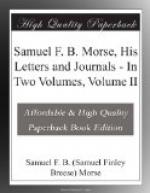While he was thus being wined, and dined, and praised by those who were interested in his scientific achievements, he harked back for a few hours to memories of his student days in London, for his old friend and room-mate, Charles R. Leslie, now a prosperous and successful painter, gave him a cordial invitation to visit him at Petworth, near London. Morse joyfully accepted, and several happy hours were spent by the two old friends as they wandered through the beautiful grounds of the Earl of Egremont, where Leslie was then making studies for the background of a picture.
The next letter to his brother Sidney is dated Copenhagen, July 19:—
“Here we are in Copenhagen where we arrived yesterday morning, having travelled from Hamburg to Kiel, and thence by steamboat to Corsoer all night, and thence by railroad here, much fatigued owing to the miserable discommodations on board the boat. I have delivered my letters here and am awaiting their effect, expecting calls, and I therefore improve a few moments to apprise you of our whereabouts.... In Paris I was most courteously received by the Count de Vouchy, now at the head of the Telegraphs of France, who, with many compliments, told me that my system was the one in universal use, the simplest and the best, and desired me to visit the rooms in the great building where I should find my instruments at work. Sure enough, I went into the Telegraph rooms where some twenty of my own children (beautifully made) were chatting and chattering as in American offices. I could not but think of the contrast in that same building, even as late as 1845, when the clumsy semaphore was still in use, and but a single line of electric wire, an experimental one to Rouen, was in existence in France.... When we left Paris we took a courier, William Carter, an Englishman, whom thus far we find to be everything we could wish, active, vigilant, intelligent, honest and obliging. As soon as he learned who I was he made diligent use of his information, and wherever I travelled it was along the lines of the Telegraph. The telegraph posts seemed to be posted to present arms (shall I say?) as I passed, and the lines of conductors were constantly stooping and curtsying to me. At all the stations the officials received me with marked respect; everywhere the same remark met me—’Your system, Sir, is the only one recognized here. It is the best; we have tried others but have settled down upon yours as the best.’ But yesterday, in travelling from Corsoer to Copenhagen, the Chief Director of the Railroads told me, upon my asking if the Telegraph was yet in operation in Denmark, that it was and was in process of construction along this road. ‘At first,’ said he, ’in using the needle system we found it so difficult to have employees skilled in its operation that we were about to abandon the idea, but now, having adopted yours, we find no difficulty and are constructing telegraphs on all our roads.’




